COMBAT OPERATIONS
(August 13, 1944 to May 8, 1945)
Back to Homepage
COMBAT OPERATIONS - 1944
The 191st Field Artillery Battalion (155 mm Howitzer, Tractor-drawn)
landed at Utah Beach, France, disembarking at 2300 on 13 August 1944, arriving
in its assembly area at 0350 on the 14th. Our forces had broken out of
the hedgerow country and were advancing rapidly eastward, requiring a long
forced march in order to reach the elements in contact.
 On
15 August the column moved out at 1000 through St. Mere Eglise, Carentan,
Periers, Coutances, Avranches, St Hiliare, Landivy, through Le Mans to
an assembly area near Le Grande Luce, and the following day on to the vicinity
of Danze, arriving at 1900, and attached to the 182nd Field Artillery Group.
The following day another move was made to the vicinity of Cloyes.
On
15 August the column moved out at 1000 through St. Mere Eglise, Carentan,
Periers, Coutances, Avranches, St Hiliare, Landivy, through Le Mans to
an assembly area near Le Grande Luce, and the following day on to the vicinity
of Danze, arriving at 1900, and attached to the 182nd Field Artillery Group.
The following day another move was made to the vicinity of Cloyes.
Positions were taken West of Chatedun on the night of 16 August, with
a mission of reinforcing the 35th Division Artillery. No firing
was done, and on the 19th a move was made to positions near Bazoches-les-Hautes.
 The
191st Field Artillery Battalion joined Combat Command A, 4th Armored Division
North of Orleans, France, on the morning of 21 August 1944, attached, the
Combat Command having as it's mission the seizing of a bridgehead at Sens.
The Combat Command consisted of the 37th Tk Bn, ioth Armd Inf Bn, 66th
FA Bn, 94th FA Bn, Co C 704th TD Bn, Co A 24th Armd Eng Bn, Co A 46th Med
Bn, Troop of 25 Cay Sq. 191st Field Artillery Battalion, and Train Elements.
1st Platoon, Battery C 452 AAA Bn (Colored) was attached to the Battalion.
The
191st Field Artillery Battalion joined Combat Command A, 4th Armored Division
North of Orleans, France, on the morning of 21 August 1944, attached, the
Combat Command having as it's mission the seizing of a bridgehead at Sens.
The Combat Command consisted of the 37th Tk Bn, ioth Armd Inf Bn, 66th
FA Bn, 94th FA Bn, Co C 704th TD Bn, Co A 24th Armd Eng Bn, Co A 46th Med
Bn, Troop of 25 Cay Sq. 191st Field Artillery Battalion, and Train Elements.
1st Platoon, Battery C 452 AAA Bn (Colored) was attached to the Battalion.
 Following
the 94th Armd FA Bn in column, the entire day was spent in moving, no positions
being occupied until the objective was reached at 1955 near Saligney, France,
East of Sens. The Combat Command in a single column, followed a route thru
Semoy, Pont-De-Boigny, Trainou, Sully-la-Chappelle, Lorey, Mignirette,
Condeville, Chateau-Landon, Souppes, Les Brosse and Sens. The total distance
was 115 miles. Intelligence sources reported large movements of enemy troops
at nearby locations during the next 24 hours, but there was no solid contact
with them by our force. The Battalion S — 4 took one prisoner South of
the position area.
Following
the 94th Armd FA Bn in column, the entire day was spent in moving, no positions
being occupied until the objective was reached at 1955 near Saligney, France,
East of Sens. The Combat Command in a single column, followed a route thru
Semoy, Pont-De-Boigny, Trainou, Sully-la-Chappelle, Lorey, Mignirette,
Condeville, Chateau-Landon, Souppes, Les Brosse and Sens. The total distance
was 115 miles. Intelligence sources reported large movements of enemy troops
at nearby locations during the next 24 hours, but there was no solid contact
with them by our force. The Battalion S — 4 took one prisoner South of
the position area.
Early on the morning of 23 August the Battalion displaced a short distance
to the East and registered at 1125. At about 1400 a flight of 6 Messerschmitt
fighters attacked the position area but were driven off without inflicting
any damage. No firing other than the base point and one check point registration
was conducted from this position.
 On
the following morning, 24 August, the Combat Command moved out at 0700
in two columns, with the mission of taking Troyes, and establishing a bridge
at that point. Battery C was attached to the 66th Armd FA Bn, moving with
the North Column, the remainder of the Battalion with the South Column.
Moving 34 miles, positions were occupied 4000 yds west of Troyes at 1400
as the tank and infantry forces developed for the attack. A hill south
of the area provided excellent observation over the entire area, and though
subject to continuous artillery fire two Observation posts were promptly
established, utilizing the first two officers available, the S—3 and S—2,
who promptly registered, and conducted observed fires on 5 enemy batteries,
a mortar battery and Infantry elements ahead of our attacking forces. Later
inspections verified 3 batteries, one 88mm and two 105mm destroyed, 6 mortars
destroyed, and another battery neutralized leaving two of it’s guns behind.
On
the following morning, 24 August, the Combat Command moved out at 0700
in two columns, with the mission of taking Troyes, and establishing a bridge
at that point. Battery C was attached to the 66th Armd FA Bn, moving with
the North Column, the remainder of the Battalion with the South Column.
Moving 34 miles, positions were occupied 4000 yds west of Troyes at 1400
as the tank and infantry forces developed for the attack. A hill south
of the area provided excellent observation over the entire area, and though
subject to continuous artillery fire two Observation posts were promptly
established, utilizing the first two officers available, the S—3 and S—2,
who promptly registered, and conducted observed fires on 5 enemy batteries,
a mortar battery and Infantry elements ahead of our attacking forces. Later
inspections verified 3 batteries, one 88mm and two 105mm destroyed, 6 mortars
destroyed, and another battery neutralized leaving two of it’s guns behind.
During this action Battery C, with the North column, kept moving, crossing
the Seine River North of Troyes during the night and fired the following
day on a town and several concentrations of enemy for the 66th FA Bn.
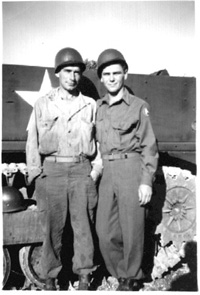 On
26 August the immediate area having been fairly well cleared of the enemy,
the Combat Command was assembled North West of Troyes and necessary maintenance
work took up the major portion of the next two days.
On
26 August the immediate area having been fairly well cleared of the enemy,
the Combat Command was assembled North West of Troyes and necessary maintenance
work took up the major portion of the next two days.
At 0700 28 August the Combat Command moved to attack Vitry-le-Francouis,
again in two columns, Battery C attached to the 66th FA Bn. Only a registration
was fired in this action, the town being taken by the time artillery was
in position. While flying patrol over the column, Lt A. T. Pumphrey who
was shot down by an enemy fighter plane (ME 109), abandoned his plane after
safely landing it. Lt Pumphrey hid in a house near our route of advance,
and was picked up a few hours later by our forces, with wounds requiring
his evacuation. The Liaison Plane was strafed after landing, and burned.
Battery C rejoined the Battalion at this position, and at 1430 the Combat
Command less a small holding force moved north to positions for an attack
on Chalons Sur Marne. The following morning the Battalion was in position
to support the attack, but practically all enemy forces had withdrawn.
One group of Infantry north of the town were despersed using ricochet fire,
obtaining many casualties. Another concentration was placed on mortars,
neutralizing them.
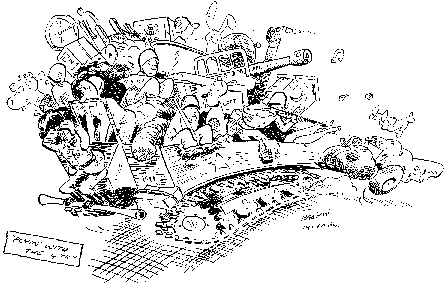
The following morning Combat Command "A" moved to sieze St Dizier,
the Battalion arriving at an area 31/2 miles West of the town at
1125. Occasional rounds of mortar fire were encountered enroute south of
Vitry-le-Francouis. During the afternoon a factory building containing
an enemy Observation Point was destroyed, and two enemy batteries were
neutralized, one of which was examined later and found to have all guns
put out of action.
Again Combat Command "A" was set up with two columns, having the mission
of taking Commercy. On 31 August, Battery C with the 66th FA Bn moved with
Task Force Jaques, the remainder of the Battalion with Task Force Abrams.
Sniper fire on the column near Ligny-en-Barrois was encountered about noon,
but no casualties were incurred. After a 40 mile move, positions were occupied
approximately 4000 yards South of Commercy as our elements entered the
town. No artillery support was required to get the town, however, and shortly
after it was cleared the Battalion moved to the East side of the Meuse
River, being rejoined by Battery C, which had just arrived. Later in the
day, several enemy columns and vehicle concentrations were taken under
fire East of Ft. De Gironville, and in the vicinity of Apremont. The hills
above Ft de Gironville, provided observation overlooking an area from Apremont
to historic Mont Sec, but was taken under fire the following day by enemy
artillery. However, Observation Points were kept in operation, and an observer,
after studying the apparent direction of fire and shelling reports, went
up in a plane, and finally at about 1900 found the guns and after covering
the area thoroughly with our fire, no more shelling was received. This
artillery was later determined to have been a battalion of Armored Artillery
of a Panzer Division which moved down during the previous night. They abandoned
the area leaving several hundred rounds of 105mm shell, and three burned
trucks.
At about 1300 on the afternoon of 1 September approximately 50 enemy
planes attacked the area with rockets and strafing, causing considerable
casualties and damage in an adjacent unit, but none in our area. Two of
the rockets landed in our battery areas.
After a protracted period of inactivity except for maintenance work,
a move was made on 11 September to positions North of Pont-a-Mousson, near
Pagny-Sur-Mosselle. Observation Points were established, and ground observers
dispersed 4 enemy Self Propelled Guns which were harassing our elements.
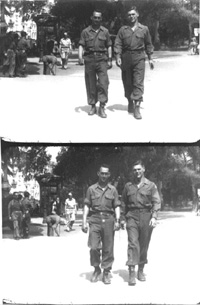 The
following day, with Battery A, attached to the 66th FA Bn, the Combat Command
crossed the Mosselle at Dieulouard and assembled beyond the high ground
East of the river at about 1800. From this position it moved out at about
1815.while receiving both mortar and scattered high velocity weapon fire
from several directions, and at about 2200 arrived in an area about 2 miles
NW of Chateau-Salins at Frasnes. Nearby enemy elements kept up continuous
small arms fire, but their objective was not determined.
The
following day, with Battery A, attached to the 66th FA Bn, the Combat Command
crossed the Mosselle at Dieulouard and assembled beyond the high ground
East of the river at about 1800. From this position it moved out at about
1815.while receiving both mortar and scattered high velocity weapon fire
from several directions, and at about 2200 arrived in an area about 2 miles
NW of Chateau-Salins at Frasnes. Nearby enemy elements kept up continuous
small arms fire, but their objective was not determined.
The next morning the entire column moved out to Arracourt, Battery A
staying in position with the 66th FA Bn to cover the debouchment and harrass
Chateau-Salins, and with other tanks and Infantry followed to Arracourt.
As the column was being formed a few rounds of hostile artillery fire fell
in the area, causing little damage, however, the forward elements were
held up for a short time. During the movement a German staff car and a
motorcycle ran into the Battalion along the road and attempted to run past
it, but were fired on and stopped, one German officer being killed, the
other occupants of the car and the motorcyclist captured. One of our men
was wounded. The column passed through Arracourt, and occupied positions
south of town.
This action marked the beginning of the most involved engagements yet
encountered. Enemy forces from Nancy and vicinity were attempting to withdraw
through the general area we occupied, and we had nightly encounters with
varying sizes of detachments, which invariably tried to fight their way
thru when challenged. During 4 days the Battalion captured 77 of these
troops and killed 8, suffering no casualties.
About 5000 yards South of our position ran the canal which connects
the Mosselle and Rhine Rivers, which we overlooked from hill 318. The area
South of this canal and the Poret-de-Parroy seemed to be highly active,
and several vehicles were destroyed in the area by observed fires. During
the ensuing time until 18 September 42 missions were fired on towns, roads,
and various enemy activities.
On 19 September a counter attack developed at about 1000 from the East.
Our forward observer reported large number of tanks with infantry at 1015
which were taken under fire, and after successive concentrations from the
66th FA Bn, 94th FA Bn, and our own Battalion the force withdrew at 1210,
leaving 5 tanks destroyed by Tank Destroyers. Again at 1330 our elements
were attacked by a stronger force and this time in one group of 8 tanks
taken under fire, 5 were knocked out, and an hour later 4 more were put
out of action by combined Artillery and Tank Destroyer fire. During the
day the Battalion fired 485 Rounds, mostly observed missions and inflicted
heavy losses on the enemy. Two of our Forward Observers directed fire on
advancing enemy elements within 200 yards of their positions, the tanks
being within direct fire range at one time of our own guns.
 On
20 September the Combat Command was to move on to Sarreguemines. Tank and
infantry elements started from the vicinity of Arracourt at about 0800,
but progress was slow, and at noon the Battalion was still in position,
waiting to take its place in column, when our observer on hill 318 reported
8 enemy tanks with infantry on them approaching our position from the South.
Battery B was shifted to meet the attack and firing charge 1 at about 1100
yards range, they were barely able to clear the hill top and lob their
shells on to the targets. There was nothing but hill 318 and the observer
between our batteries and this attacking force but the fire which was delivered
knocked out two of the tanks, caused heavy casualties amongst the infantry
and dispersed the entire force which withdrew.
On
20 September the Combat Command was to move on to Sarreguemines. Tank and
infantry elements started from the vicinity of Arracourt at about 0800,
but progress was slow, and at noon the Battalion was still in position,
waiting to take its place in column, when our observer on hill 318 reported
8 enemy tanks with infantry on them approaching our position from the South.
Battery B was shifted to meet the attack and firing charge 1 at about 1100
yards range, they were barely able to clear the hill top and lob their
shells on to the targets. There was nothing but hill 318 and the observer
between our batteries and this attacking force but the fire which was delivered
knocked out two of the tanks, caused heavy casualties amongst the infantry
and dispersed the entire force which withdrew.
It was decided to abandon the projected mission, and the Battalion,
which had been March Ordered by this time to join the column, moved to
a position 1 mile north of Arracourt, and laid one battery north, one east
and one south, firing on tank and vehicle concentrations in each direction.
The day ended with 4 known tanks knocked out, 4 other vehicles destroyed,
and an attack completely broken up solely by our fire. Expended 232 Rounds
of Shell, 11 Rounds of Smoke.
During the ensuing period until 7 October actions were defensive. On
22 September Battery A displaced about 3000 yards to the East to reinforce
the 94th FA Bn, but was withdrawn on the 24th after being heavily shelled
and incurring 9 casualties. A Forward Observer working with the 10th Armd
Inf Bn was killed on this same day by enemy tank fire. Harassing fires
were kept up by the enemy continuously and we received many rounds in and
around our areas. On 25 September positions were taken up North West of
Athienville to avoid further shelling and on the 27th the 177 Field Artillery
Group took over operational control of the Battalion, (During the entire
period covered by this narrative, the Battalion had been attached to the
177th Field Artillery Group but due to the nature of the operations had
worked entirely under the control of the 4th Armored Division Artillery).
 On
the 3 October the lines had been fairly well established and the Battalion
moved, forward to the original area it had occupied South of Arracourt.
On the 5th a heavy concentration of artillery fire was placed on the area
and we lost the Ass’t S -- 3 and two men killed, two wounded. The 4th Armored
Division was relieved on 7 October by the 26th Inf Div, and the Battalion
assumed a reinforcing role, supporting the attack of the 2 6th. From 21
September until 7 October 12 enemy batteries were fired on with observed
neutralizing effect, other missions included 1 tank knocked out and several
vehicles destroyed.
On
the 3 October the lines had been fairly well established and the Battalion
moved, forward to the original area it had occupied South of Arracourt.
On the 5th a heavy concentration of artillery fire was placed on the area
and we lost the Ass’t S -- 3 and two men killed, two wounded. The 4th Armored
Division was relieved on 7 October by the 26th Inf Div, and the Battalion
assumed a reinforcing role, supporting the attack of the 2 6th. From 21
September until 7 October 12 enemy batteries were fired on with observed
neutralizing effect, other missions included 1 tank knocked out and several
vehicles destroyed.
On 23 October the Battalion took up the mission of General Support of
the 26th Infantry Division, reinforcing the 102nd Field Artillery Battalion.
The Division launched several limited objective attacks during the following
week, with some local successes. Restrictions on our ammunition expenditure
curtailed firing considerably.
A move was made to positions near Leyr on 31 October, leaving 2 sections
of Battery "A" in position to fire harassing fire. The move was made at
night and all precautions were taken to prevent the disclosure of changes
to the enemy. The Division Artillery assumed tactical control on 1 November.
On the night of the 7th the batteries were moved forward above 1500 yards
and the two sections left in the previous position were brought up.
Beginning at 0500 on the 8th in a drenching downpour of rain, a preparation
in support of the Corps attack was fired. 635 rounds were expended.
 Combat
Command "A" of the 4th Armored again moved to attack on 9 November, the
177 Field Artillery Group supporting; this Battalion under Division Artillery,
assembling near Hoeville and Bezarge-Le-Grande, and attacking Hampont on
the 11th. Positions were occupied just West of the town at 1800, but we
were unable to deliver any effective fire due to confused situation and
harassing fire from nearby enemy tanks which shot into the area during
the entire night. The next day a move was made to the Foret-de-Koecking
Bride, positions being occupied at dusk. From this position harassing fires
and observed missions were delivered on towns and enemy formations. One
group of 6 tanks of the enemy were fired on by Battery C which were holding
up our advance near a defile and were completely neutralized, the battery
firing 150 rounds in 10 minutes. The position here was along a ridge, with
enemy on both sides, subject to both direct and indirect fire. However,
by using the available defilade of trees we avoided any damage.
Combat
Command "A" of the 4th Armored again moved to attack on 9 November, the
177 Field Artillery Group supporting; this Battalion under Division Artillery,
assembling near Hoeville and Bezarge-Le-Grande, and attacking Hampont on
the 11th. Positions were occupied just West of the town at 1800, but we
were unable to deliver any effective fire due to confused situation and
harassing fire from nearby enemy tanks which shot into the area during
the entire night. The next day a move was made to the Foret-de-Koecking
Bride, positions being occupied at dusk. From this position harassing fires
and observed missions were delivered on towns and enemy formations. One
group of 6 tanks of the enemy were fired on by Battery C which were holding
up our advance near a defile and were completely neutralized, the battery
firing 150 rounds in 10 minutes. The position here was along a ridge, with
enemy on both sides, subject to both direct and indirect fire. However,
by using the available defilade of trees we avoided any damage.
Subsequent missions through 21 November were routine, principally harassing
fires on towns and a few observed missions on enemy formations. The weather
was continuously bad, terrain was so soft only tractors could operate at
all off roads and they were frequently mired down. In support of the continuing
attack positions were occupied near Rodalbe on the 18th and Virming on
the 21st. On 21 October the Battalion was relieved of attachment to the
177 Field Artillery Group and moved to reinforce the 6th Armored Div Artillery.
On 22 November the Battalion moved to the vicinity of Hemering, in General
Support of the Sixth Armored Division, attached to the 183rd Field Artillery
Group. On the 23rd the 191st moved to positions at Freybouse. Here "B"
Battery received continuous harassing fire, but suffered no casualties
or damage. The task force made little progress in its attack until the
following day.
On the 25th positions were occupied at Diffenbach, and on the 28th at
Leyviller. From here missions were fired in support of the continuing attack,
until 4 December when a move was made to Ferschviller, and the following
day Battery "A" was moved near Diebling, being followed by the remainder
of the Battalion on the 7th.
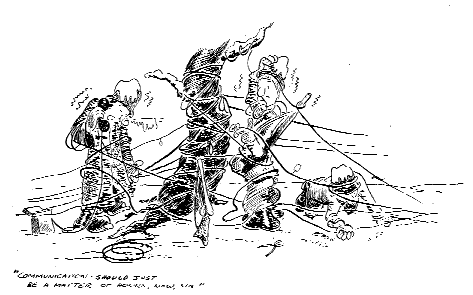 The
mission was again changed to General Support of the 35th Infantry Division,
the Battalion being attached to the 182nd Field Artillery Group. Positions
were occupied 1½ miles SW of Bliesbrucken, Germany, reinforcing
the 216th Field Artillery Battalion.
The
mission was again changed to General Support of the 35th Infantry Division,
the Battalion being attached to the 182nd Field Artillery Group. Positions
were occupied 1½ miles SW of Bliesbrucken, Germany, reinforcing
the 216th Field Artillery Battalion.
Reconnaissance was made for positions East of Bliesbrucken, while firing
in support of the 35th Infantry Division attack, but these were not occupied.
On December 21st notice was received of preparations to shift our forces
to the North, and at 1000 parties left for Luxembourg, arriving late that
night. The Battalion closed station at 2230, and after a tedious and rain-soaked
march reached the I. P. at Mitterscheim at 0345. Passing through Pont-a-Mousson
and Metz, Esch, Luxembourg and the city of Luxembourg, positions were reached
by nine sections near Nommern at 1630 on the 22nd, and immediately started
interdiction fires on areas to the Northeast. Some of the tractors did
not complete this march until the 24th. The rapid rate over the 162 mile
march caused much difficulty with the tracks.
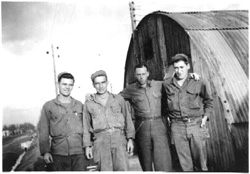 These
positions were occupied until 29 December, supporting successively the
10th Armored Division, Fifth Infantry Division, 6th Armored Division. Heavy
snow and sub-zero weather made living conditions out in the open extremely
difficult.
These
positions were occupied until 29 December, supporting successively the
10th Armored Division, Fifth Infantry Division, 6th Armored Division. Heavy
snow and sub-zero weather made living conditions out in the open extremely
difficult.
On the 29th a short move was made to the vicinity of Schrondweiler and
the mission again changed to support of the Fifth Infantry Division, reinforcing
the 50th Field Artillery Battalion. These positions were organized as defensive,
and two successive rearward areas reconnoitered and surveyed. Firing was
principally harassing, a few counter battery targets and infantry were
picked up.
Back to Homepage
 On
15 August the column moved out at 1000 through St. Mere Eglise, Carentan,
Periers, Coutances, Avranches, St Hiliare, Landivy, through Le Mans to
an assembly area near Le Grande Luce, and the following day on to the vicinity
of Danze, arriving at 1900, and attached to the 182nd Field Artillery Group.
The following day another move was made to the vicinity of Cloyes.
On
15 August the column moved out at 1000 through St. Mere Eglise, Carentan,
Periers, Coutances, Avranches, St Hiliare, Landivy, through Le Mans to
an assembly area near Le Grande Luce, and the following day on to the vicinity
of Danze, arriving at 1900, and attached to the 182nd Field Artillery Group.
The following day another move was made to the vicinity of Cloyes.









